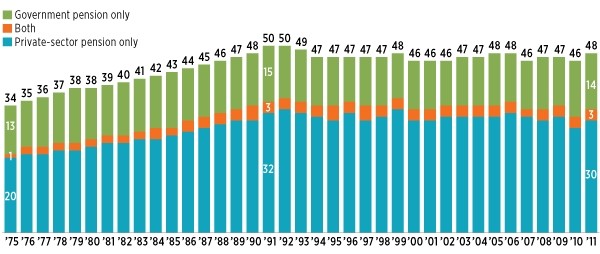
News Release
Private-Sector Retirement Plan Income Steady
Study Finds Such Plans Continue to Play Important Role for Retirees
Washington, DC, October 22, 2012 -The annual update of an ICI research study finds that, contrary to conventional wisdom, retirees across all income groups are collecting more in retirement income today from employer-sponsored retirement plans than they were in the mid-1970s, when sweeping new retirement plan regulations were enacted.
The study, A Look at Private-Sector Retirement Plan Income After ERISA, 2011, finds that in 2011, 33 percent of retirees received income—either directly or through a spouse—from private-sector retirement plans, compared with 21 percent in 1975. The median income received by those with private-sector pension income was $6,300 in 2011 compared with about $4,700 in 1975 (in 2011 dollars). The research examines private-sector retirement income trends since 1974, just after the Employee Retirement Income Security Act (ERISA) was enacted.
Receipt of Income from Pension by Type of Pension
Percentage of retirees* with type of pension, 1975–2011

*Individuals aged 65 and older with nonzero income and not working; for married couples, neither the individual nor the spouse was working. Sample excludes highest 1 percent and lowest 1 percent of the income distribution.
Source: ICI tabulations of the March Current Population Survey
“As policymakers consider retirement savings policies, it is important that they understand that private-sector pension income has tended to increase over time rather than decrease. The share of retirees receiving private-sector pension income increased by more than 50 percent between 1975 and 1991, and has remained fairly stable since,” said Peter Brady, ICI senior economist and coauthor of the report. “Further, among those receiving income from private-sector pensions, the median amount of inflation-adjusted income—which had remained fairly flat between 1975 and 1991—has increased nearly 40 percent since 1991.”
Other Key Findings: Access, Coverage, Role of Social Security
- Increase in DC plan coverage over time has kept U.S. worker access to private-sector retirement plans steady since the 1970s. While coverage has been consistent, an increasing share of private-sector workers has worked for employers that sponsor defined contribution (DC) pension plans, and a decreasing share has worked for employers that sponsor defined benefit (DB) pension plans. In 1975, nearly 90 percent of active participants in private-sector retirement plans had primary coverage through DB plans, dropping steadily over time to below 50 percent by the 1990s. By 1998, 44 percent of active participants in private-sector retirement plans had coverage through DB plans.
- Coverage by a pension plan does not always result in retirement income. The historical prevalence of retirement income from private-sector DB plans may be overstated by only looking at pension coverage, rather than receipt of pension income. Many retirees may have worked for companies that offered DB plans, but, because private-sector workers change jobs often, the combination of vesting rules and back-loaded benefit accrual resulted in many retirees getting little or no retirement income from private-sector retirement plans.
- Social Security plays key role in retirement. Social Security benefits continue to serve as the foundation for retirement security in the United States and represent the largest component of retiree income and the predominant income source for lower-income retirees. In 2011, Social Security benefits were 57 percent of total retiree income and more than 85 percent of income for retirees in the lowest 40 percent of the income distribution.
The study was coauthored by Brady and ICI associate economist Michael Bogdan. Supplementary figures with additional detail can be found here: www.ici.org/info/per18-05_data.xls.
